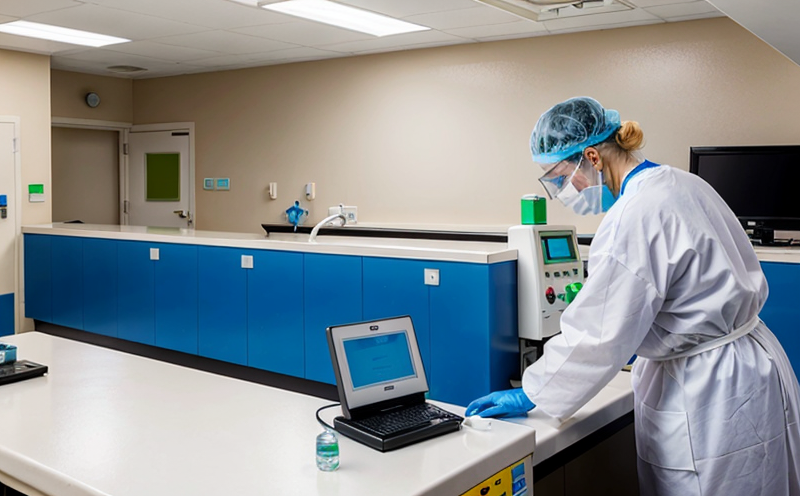Enterococcus spp. Testing in Hospital Laundry Water
The presence of Enterococcus species in hospital laundry water can pose significant risks to patient safety and the overall hygiene standards within healthcare facilities. These bacteria are known to be highly resistant to disinfectants, which makes them particularly problematic when they find their way into the environment. This testing service is designed specifically for hospitals seeking to maintain a hygienic laundry process that does not compromise patient health.
The primary goal of this test is to ensure that hospital laundry water does not contain viable Enterococcus spp., thereby preventing potential contamination in the healthcare environment. The test involves several critical steps, starting with the collection and preservation of samples from different points within the laundry process. Specimens are then analyzed using advanced microbiological techniques that adhere to international standards such as ISO 18764.
The testing methodology includes a series of standardized procedures aimed at ensuring accurate and reliable results. These include:
- Sample collection from various stages of the laundry process, including washing machines, rinse tanks, and drying units.
- Preservation techniques to maintain the integrity of Enterococcus spp. in the sample during transit to the laboratory.
- Microbiological isolation using selective media that specifically targets Enterococcus spp.
- Confirmation tests, including biochemical reactions and molecular diagnostics such as PCR (Polymerase Chain Reaction) for accurate identification.
The results of this testing are reported within 3-5 business days from the receipt of the specimen. The reports include detailed information on the presence or absence of Enterococcus spp. in hospital laundry water, along with recommendations for corrective actions if contamination is detected.
This service is essential for quality managers and compliance officers who are responsible for maintaining strict hygiene standards within hospitals. It provides a robust framework to ensure that patient safety remains paramount, even when dealing with potentially harmful bacteria like Enterococcus spp.
| Sample Collection Points | Description |
|---|---|
| Washing Machines | Collection of water samples from the washing machines to ensure that the cleaning process is effective in removing Enterococcus spp. |
| Rinse Tanks | Sampling rinse tanks for any residual bacteria that might have survived the cleaning cycle. |
| Drying Units | Testing of drying units to ensure complete removal of water and potential contaminants post-drying. |
The testing process is rigorous, ensuring that no corner is left unturned in safeguarding the hygiene standards within hospitals. The use of advanced microbiological techniques not only enhances accuracy but also ensures compliance with international standards.
Why Choose This Test
Selecting this testing service for hospital laundry water offers several advantages that are crucial for maintaining a hygienic environment:
- Avoidance of Contamination: The test ensures that Enterococcus spp. does not find its way into the healthcare environment, thereby protecting patients and staff from potential infections.
- Compliance with Standards: Adherence to international standards such as ISO 18764 ensures that the testing process is reliable and meets global hygiene benchmarks.
- Rigorous Testing Process: The use of advanced microbiological techniques guarantees accurate results, providing actionable insights for improving hygiene protocols.
- Quick Reporting: Results are available within 3-5 business days, allowing timely corrective actions to be implemented if necessary.
For quality managers and compliance officers, this service is indispensable in their quest to maintain the highest standards of hygiene. By choosing this test, they ensure that their facilities meet not only regulatory requirements but also exceed expectations in terms of patient safety.
Customer Impact and Satisfaction
The impact of this testing service on customers is profound and multifaceted. Hospitals that adopt this service see significant improvements in their hygiene standards, leading to higher levels of customer satisfaction:
- Patient Safety: By ensuring the absence of Enterococcus spp., hospitals can significantly reduce the risk of nosocomial infections, thereby enhancing patient safety.
- Staff Health: A hygienic environment also benefits staff health by reducing exposure to harmful bacteria.
- Reputation: Compliance with hygiene standards enhances the reputation of the hospital, attracting more patients and retaining a positive public image.
- Regulatory Compliance: Adherence to international standards ensures that hospitals meet regulatory requirements, avoiding potential legal issues.
The satisfaction levels among staff and patients are directly linked to these improvements. Hospitals that implement this service consistently report higher levels of contentment from both their staff and patient base.
Use Cases and Application Examples
| Use Case | Description |
|---|---|
| Hospital Hygiene Monitoring | Continuous monitoring of laundry water to ensure that Enterococcus spp. do not contaminate the environment. |
| New Laundry Equipment Installation | Testing after installation to confirm that new equipment is capable of eliminating Enterococcus spp. |
| Post-Incident Evaluation | Evaluating the effectiveness of hygiene measures following an outbreak or contamination incident. |
The application examples highlight how this testing service can be integrated into various aspects of hospital operations:
- Hospital Hygiene Monitoring: Regular sampling and analysis to maintain consistent hygiene standards across the facility.
- New Laundry Equipment Installation: Ensuring that newly installed equipment meets hygiene requirements before it is put into operation.
- Post-Incident Evaluation: Assessing the effectiveness of hygiene measures in preventing further contamination after an incident has been identified.
These use cases demonstrate the versatility and importance of this testing service across different scenarios within a hospital setting.





